Yield Farming - Yearn Finance - Crypto Academy S5W3 - Homework Post for @imagen
Hello guys, it's a new week with fresh courses available to us for our uptake. I will be participating in coursework presented by professor @image on Yield Farming_Yearn Finance. Let's get started here...


(1.) Describe the differences between Staking and Yield Farming.

Before we can vividly differentiate these twin components of blockchain income drivers, we have understood their purpose of development, underlying technology, rewards scheme, and as well their Risk factors which I believe to a great extent we can relate to. While Yield Farming basically tells us how best-obtaining returns for crypto-assets can be relative to its flexible methods in earning passive income whereas Staking entails setting aside or locking up crypto assets as collateral to leverage on the blockchain network.
In short find below a more overview difference between this duo for our understanding;
| Yield Farming | Staking |
|---|---|
| A designed approach in the blockchain launched for passive income generation by acts of locking up crypto assets | Purpose of locking up of assets is skewed towards being able to participate in governance issues in the Network of being selected as a validator which also comes with its returns/rewards. |
| Yield Farming primarily works and execute transaction and activities with Automated Market makers (AMM) | Drives and operates primarily with the existing consensus mechanism of Network |
| Rewards are received by the use of the APY/APR of the underlying asset set and locked at that given time | For the primary purpose of staking which may be for validation, rewards are received in native token observed in the blockchain. |
| The risk associated with the project include Liquidation risk, Impermanent risk, and maybe Smart Contract risk | Staking has a long list of risks in the Network which includes Liquidity risk, Longer Reward waiting period, Volatility risk, Validator risk as well counterparty risks. |

(2.) Login to Yearn Finance. Explore the platform completely and indicate its functions. Describe the process for trading on the platform (wallet connection, funds transfer, available options) Show screenshots.

Login to Yearn Finance
Login into the Yearn finance is simple especially through the use of the MetaMask app, therefore I will be demonstrating this process using the Metamask
- Launch your Metamask App from your device
- Click on the Menu button from your Top left screen
- Click on the Browser option from the listed options
- Search for the "Yearn Finance" from the search box to launch in the Yearn Finance
- Then click on the connect wallet
- Click on the Metamask option
- Click on connect button









Explore the platform completely and indicate its functions

We have the different features shown from the landing page which include the following;
The Wallet
This screen avails the user the opportunity to safeguard tokens and earnings in the protocol. It showcases the Dashboard and asset worth in a glance.

The Vaults
This is another interface that showcases the asset holdings, Earnings as well Estimated yearly yield of a user project in the Yearn Finance. The Vault help users to manage their holdings as well go for strategies best for them which relatively maximizes yield as well rebalancing. Remember that asset custody and its responsibility still saddles in the hands of the user with the capacity to withdraw anytime.

The Labs
This is an option that provides information and updates on emerging and newest strategies in the protocol. But it is the wisdom we understand them before using as there are still risks from token locking, impermanent, and liquidation loss.

The Iron Bank
This happens to be a little advance over the vault as users are exposed to a series of tokens that may not be available through the vault. Users can now borrow tokens with their available assets as collateral without necessarily having to buy new tokens. The interface displays the user's Supplies, Borrowings, borrowed limits, and total borrowed limits. In all of this, this exposure comes with the contract and systemic risks which users should be aware of.

Users who want to Supply or Borrow can click on the token of interest just as shown below. From the Supply option, the user is to input the amount to be supplied while taking into cognizance the borrowing limit. Supply APY for the USDT stands at 8.34%. Then click on the Approve Button to sign the transaction.


This is also applicable to the Borrow option. The borrowing limit indicated, with the APY standings at 10.95% before clicking on the Borrow button.

3- What is collateralization in Yield Farming? What is its function?

Overview of Collateralization in yield farming
We have to understand what collateralization is before its application in Yield farming. This term simply means an act of using some valuable assets to secure the use of a loan. The essence of collateralization of assets is to give liquidity providers some level of the lifeline that their locked-up asset in the liquidity is well secured despite being traded upon by borrowers who may want to default. Hence both providers of liquidity and borrowers of liquidity have some form of checks to avoid any form of breach.
Collateralization in the DeFi space which the Yield farming borrows a leave from entails that the borrower(s) lock up some asset value to have access to a loan in the liquidity pool. This very act of locking up assets for an anticipated loan facility is known as Collateralization. This is necessary for yield farming as pledged assets (collateralized assets) by borrowers are observed to be a repayment base should incase they default while using this liquidity.
Due to the workability and protocol observed in the DeFi space with the AMM riding on smart contract, breaches from borrowers are greatly removed as the system rebalances itself to bring balance in the liquidity pool as a locked asset. It brings about accountability from borrowers as the mainstay of DeFi (Yield farming) is lending (provide liquidity). There are scenarios where borrowers are expected to over-collateralize their assets vis-a-vis the loan value. In some cases, the system protocol is observed to set a borrowing limit that cannot be exceeded.
Also in collateralization, there are protections as observed in the traditional Financial firms where loan insurance are initiated and put in place whereas the DeFi space like the Yield farming only take into cognizance the over-collateralization and borrow limits put in place. In some cases, borrowers who default are vulnerable to the private key or collateral hacks and hence which could lead to loss of assets.
Liquidity providers which give rise to the need for collateralization are rewarded from activities of borrowers and transaction fees in the liquidity pool. Rewards are distributed based on contributions in the liquidity pool.
Function of Collateralization in Yield farming
Just as discussed above, the function of collateralization cannot be over-emphasized as this plays a crucial role in the protection of the lenders in the DeFi space, Since a borrower is observed to lock up some certain amount of assets to have access to a given required loan, it brings about protection, security and guaranteed trust in system protocol. With collateralization, liquidity providers would have every reason to continue providing in the pool since this also serves as a means of generating passive income from the system.

4- At the time of writing your assignment, what is the TVL of the DeFi ecosystem? What is the TVL of the Yearn Finance protocol? What is the Market Cap / TVL ratio of the YFI token? Show screenshots.

What is the TVL of the DeFi ecosystem
As at the time of writing this post, the Total Value Locked (TVL) of the DeFi ecosystem can be simply gotten through the DeFi Pulse by navigating through https://defipulse.com.
Therefore the TVL stands at $109.07B.
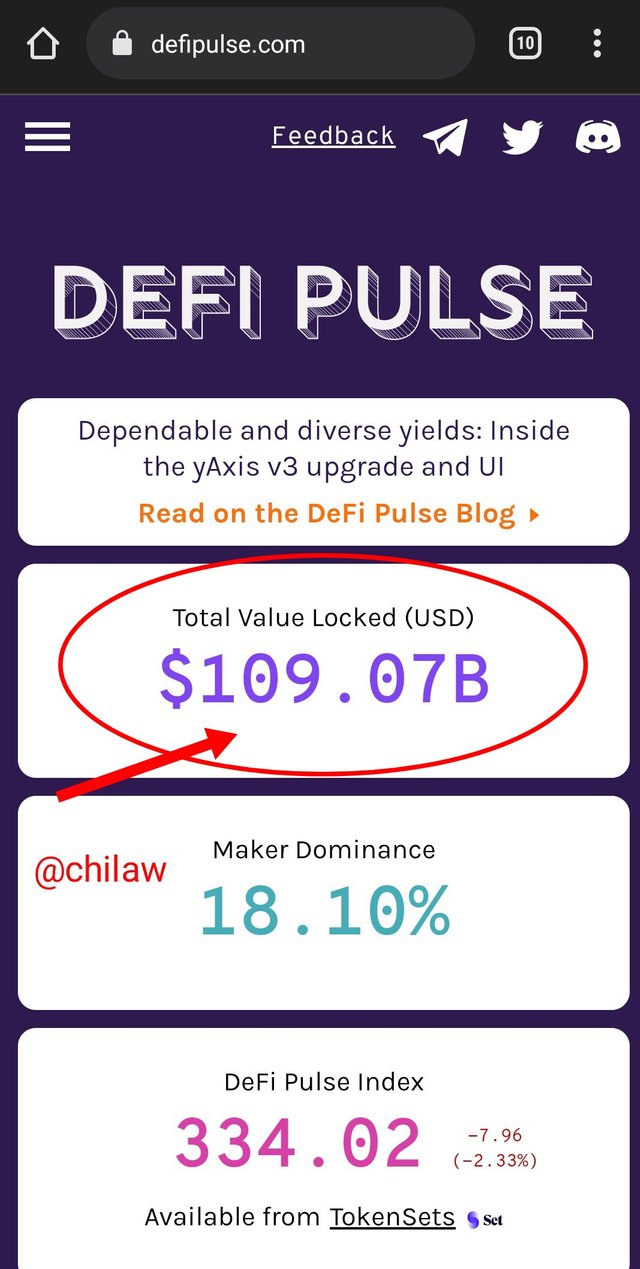
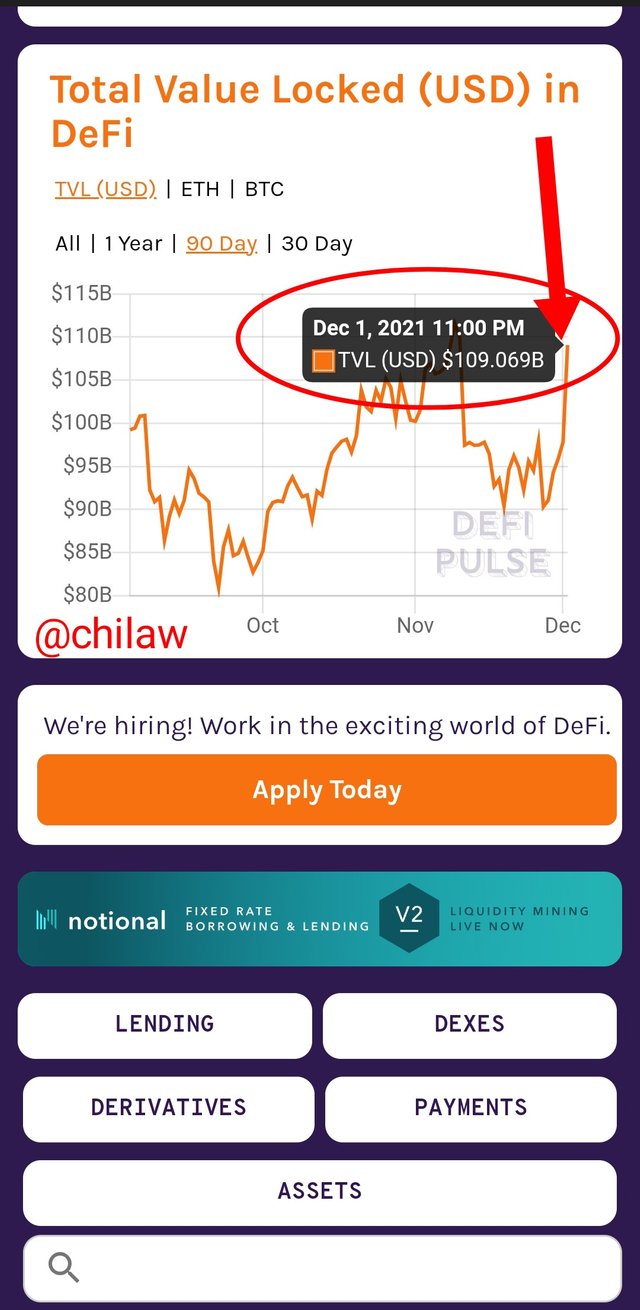

The TVL of the Yearn Finance Protocol
To get this, we only need to scroll down the same page where we saw the total TVL value. The Yearn Finance Protocol stands at $4.54B.
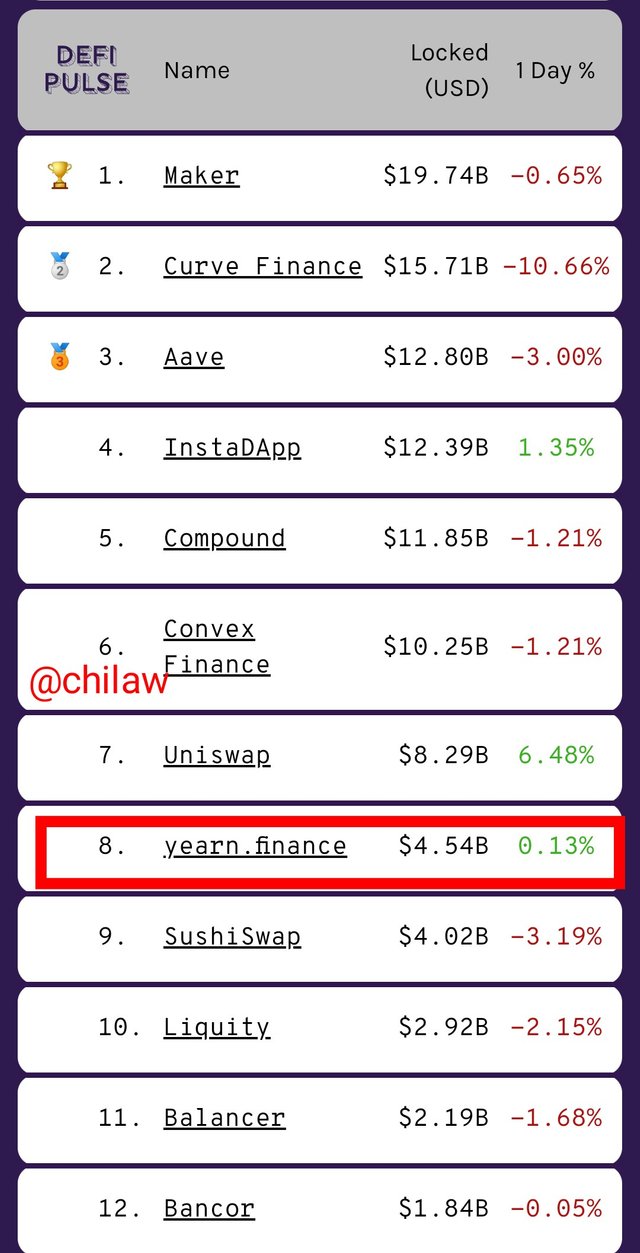
From the list of DeFi, we can see the Yearn Finance Protocol was observed in the Top 8 position. But in knowing the makeup or build of the TVL value for the Yearn Finance Protocol, we can click on the project for a more explicit value.
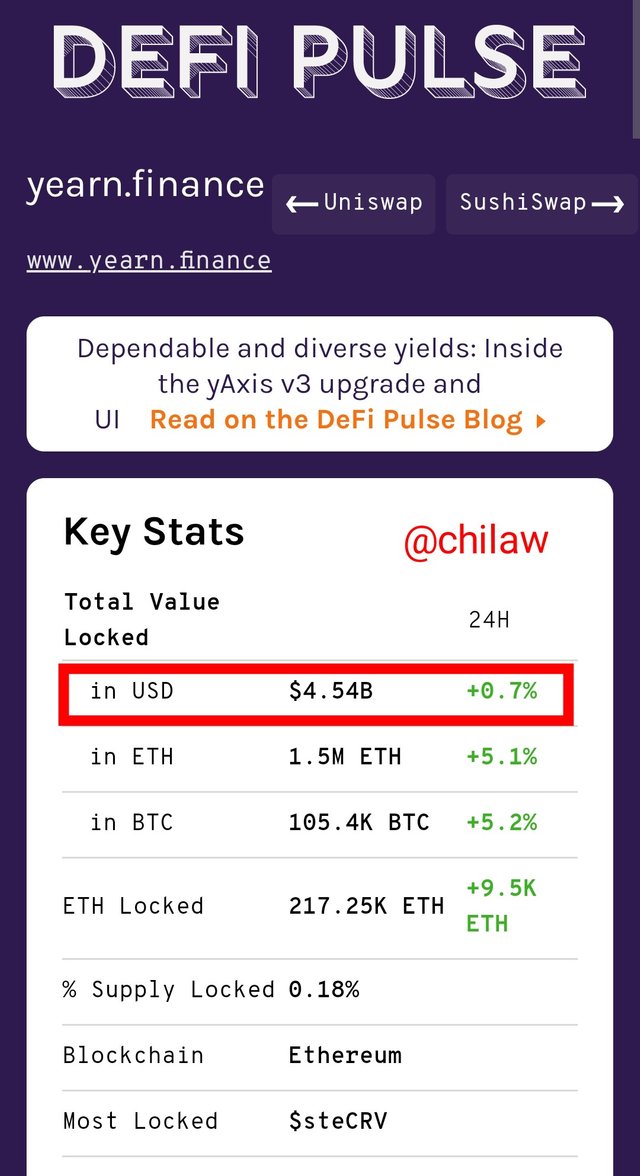
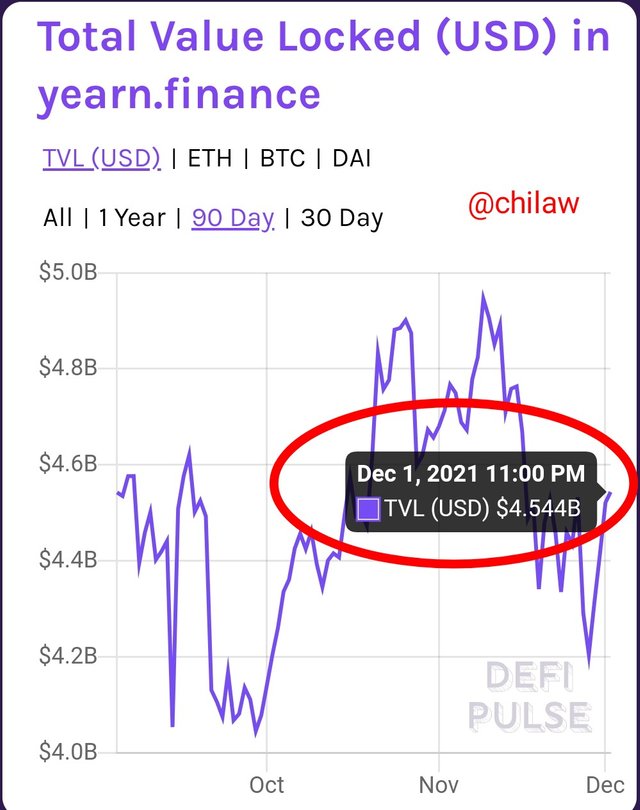

All images used for this question are screenshots from the DeFi Pulse sites and done through my Mobile
The Market Cap/TVL ratio of the YFI token
I will be sharing this information with us using the Coinmarketcap site. From the site we have the following information;
- Market Cap: $1,058,757,085
- Circulating Supply: 36,637.72 YFI
- Total Value Locked: $6,102,154,452
- Price Value: $28,955.36
- Market Cap/TVL Ratio: 0.1736
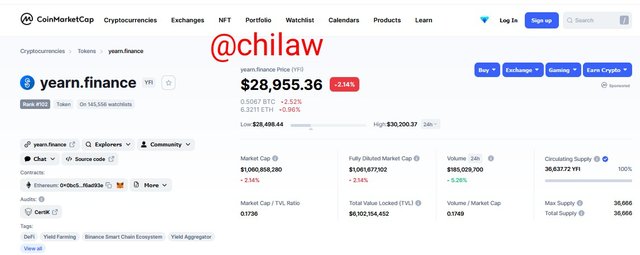
(Screenshot from coinmarketcap site)
(4.1.) The YFI token, is it overvalued or undervalued? State the reasons.
An asset is said to be overvalued when its ratio is equal or greater than one and Undervalued when it is less than one.
From what we have from the Coinmarketcap site, the Market Cap/TVL Ratio is observed to be less than one with a value of 0.1736.

(5.) If on August 1, 2021, you had made an investment of 1000 USD in the purchase of assets: 500 USD in Bitcoin and the remaining 500 USD in the YFI token, what would be the return on your investment in the actuality? Explain the reasons

Return On Investment _BTC

Price of BTC on 21/8/2021: $48,954.8
Therefore $500 investment on 21/8/2021 : 0.010213503BTC
With the Current price of BTC @ $56,780.67
0.010213503BTC = ($56,780.67 x $500)/$48,954.8 = $579.9295472
OR
0.010213503BTC in 21/8/2021 is now = 0.011846224BTC in 2/12/2021
[(56,780.67 x 0.010213503)/48,954.8]
Therefore the ROI_BTC is $79.9295472 or 0.011846224BTC
This represents 15.99%
Return On Investment _YFI

Price of BTC on 21/8/2021: $38,798.5
Therefore $500 investment on 21/8/2021 : 0.012887096 YFI
With the Current price of YFI @ $28,650.25
0.012887096 YFI = ($28,650.25 x $500)/$38,798.5 = $369.215
OR
0.012887096 YFI in 21/8/2021 is now = 0.009516309 YFI in 2/12/2021
Therefore the ROI_YFI is $130.785 or 0.009516309 YFI
This represents -26.157%
Therefore Total ROI for MOney invested : $79.929 - 130.785 = -$50.856
Explanation
This clearly shows that there were positive investment returns from the BTC asset but the Yield farming investment was observed with negative returns. This simply shows that even though yield farming is a lucrative business, it still comes with its shortcomings. Its token is subject to depreciation and volatility of market trends. There are also risks associated with providing liquidity which include Smart contract risk, impermanent loss, and liquidation risks.

(6.) In your personal opinion, what are the risks of Yield Farming? Give reasons for your answer.

There are no perfect project but every emerging project are always observed to come with an improvement vis-a-vis existing DeFi, hence the risk associated therein. Some of the risks associated with the DeFi or Yield farming include;
- Liquidation Risk: This is one of the obvious risks observed to be associated with the DeFi protocol. The amount of liquidity provided in a pool is dependent on the LPs and hence there are possible cases of going out of liquidity because of the unprecedented pull of cash out of the pool. A typical and recent case is that of the Iron Finance of March 17, 2021, where $170,000 worth of the SIL tokens were pulled by an LP and hence drained the liquidity in the pool which resulted in a loss for participants therein.
- Smart Contract Loss: This is another form of risk emanating from the protocol given that the DeFi system runs on the smart contract to execute all activities. There may be cases of intentional risk where bugs are observed in smart contracts with possible locking up of tokens.
- Developer Risk: We all know projects are created by developers which makes their origin known and not manna. Hence there is the likelihood of misappropriation from developers which jeopardizes the essence and purpose of the pool and participants. In the case of the SushiSwap DeFi where Chef Nomi and the anonymous developer lured investors into this project and later withdrew all the available start-up funds that render the system worthless. Though there were come back made, this and many more are incidences and risks observed in DeFi projects.

Conclusion

The world of DeFi has continued to evolve with the continuous emergence of projects which are poised in changing the narratives of the traditional financial system relative to loan assessment. The Backbone of the DeFi space has centered on lending and the collateralization of its assets has come a long way in putting checks in activities of borrowers, hence the protection given to liquidity providers.
By the over-collateralization of tokens, investors or liquidity providers now have a passive source of income and as well make earnings from leverage trading in the system protocol. Despite the limitations and risks observed in the activities of Yield Farming, it has continued to increase its market cap which significantly shows its adoption, acceptance, and a veritable source of financial independence from the old financial system.
Thank you Prof @imagen for your lessons
